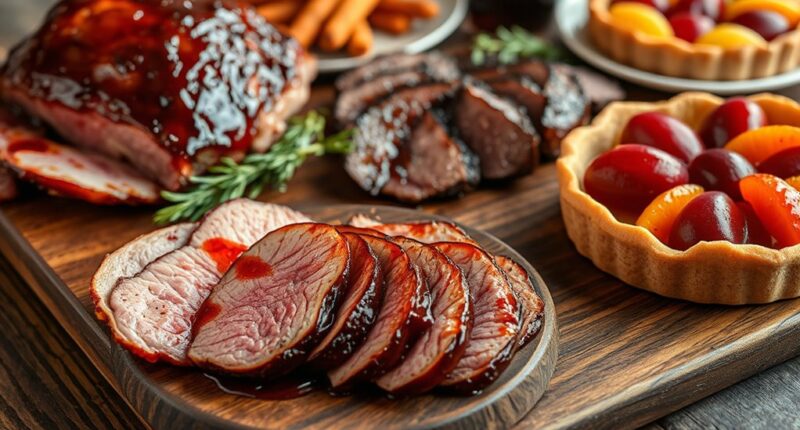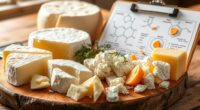Many foods contain hidden alcohol sources that you might overlook, such as marinades, dressings, and glazes, or desserts like tiramisu and baked goods. Alcohol can also be present in packaged sauces, candies, and flavorings, sometimes in small amounts that are easy to miss. Cooking methods and duration affect how much alcohol remains. Staying aware of ingredient labels and cooking techniques helps you avoid unintentional consumption—continue exploring to uncover more surprising sources.
Key Takeaways
- Alcohol is often hidden in marinades, dressings, glazes, and desserts like tiramisu or baked goods.
- Cooking methods and duration influence how much alcohol remains in food, with longer simmering reducing content.
- Packaged and processed foods may contain alcohol-based preservatives, flavorings, or additives not immediately obvious.
- Small amounts of alcohol can be present in candies, chewing gums, and non-alcoholic beverages due to flavorings.
- Always check ingredient labels carefully to identify hidden alcohol sources and avoid unintended consumption.

Have you ever wondered how alcohol ends up in your food? It’s a common question, especially for those who want to avoid alcohol for health, religious, or personal reasons. The truth is, alcohol is an ingredient in many dishes you might not even realize contain it. Chefs often use wine, beer, or spirits to enhance flavors, tenderize meats, or create complex sauces. When these dishes are cooked, some alcohol evaporates, but not all of it. The amount remaining depends on the cooking method, duration, and temperature. For example, simmering a sauce for hours can reduce alcohol content markedly, but quick flambé or high-heat cooking might leave more alcohol behind. This means that even if you’re not drinking wine or beer, you could still be consuming small amounts through your meals.
Beyond obvious dishes like coq au vin or beer-battered fish, alcohol sneaks into a variety of other foods you may not suspect. Think about marinades, salad dressings, glazes, or desserts like tiramisu and certain cakes. Many recipes call for alcohol to add depth and aroma, but it’s easy to overlook these ingredients. Packaged foods and ready-made sauces often contain alcohol-based preservatives or flavorings. Even some fruit preserves or jams include alcohol to extend shelf life or enhance flavor. It’s not just about the main ingredient; alcohol can be present in minute quantities that are hard to detect without careful scrutiny.
Alcohol often hides in marinades, dressings, desserts, and processed foods, sometimes in tiny, unnoticed amounts.
Even if you’re cautious about alcohol in your diet, it’s worth knowing that some hidden sources might catch you off guard. For example, some non-alcoholic beverages, like certain kombuchas or flavored waters, may contain trace amounts of alcohol due to fermentation. Additionally, certain candies and chewing gums include alcohol-based flavorings to improve taste. These small amounts usually aren’t a concern for most people, but if you’re avoiding alcohol for medical, religious, or personal reasons, it’s smart to read labels carefully. Some products are explicitly labeled as alcohol-free, but many are not, so paying attention to ingredients helps you make informed choices.
Understanding how alcohol gets into your food empowers you to decide what’s right for your diet. Whether you’re cooking at home or eating out, knowing that alcohol can be present in subtle ways helps you navigate menus and ingredient lists more confidently. While the amounts are generally small, awareness is key—especially if you’re sensitive to alcohol or need to avoid it entirely. Ingredients lists can sometimes reveal hidden alcohol content that might otherwise go unnoticed. By being informed about these hidden sources, you can enjoy your meals without surprises, ensuring your food choices align with your health and lifestyle goals.
Frequently Asked Questions
Can Children Safely Consume Foods Containing Alcohol?
Children should not consume foods containing alcohol. Even small amounts can affect their developing bodies and lead to health issues or behavioral changes. As a parent or caregiver, you need to carefully read labels and ask about ingredients when preparing meals or snacks. Avoid dishes with wine, beer, or spirits, and opt for alcohol-free alternatives to guarantee your child’s safety and well-being at all times.
How Much Alcohol Remains After Cooking or Baking?
After cooking or baking, most of the alcohol evaporates, but a small amount can still remain—anywhere from 5% to 85%, depending on cooking time and temperature. Ironically, that tempting, flambéed dessert might still contain enough alcohol to surprise you. So, if you’re avoiding alcohol completely, remember that some residual traces can linger, especially in recipes with short cooking times or high alcohol content.
Are Non-Alcoholic Wines and Beers Free of Alcohol?
Non-alcoholic wines and beers typically contain up to 0.5% alcohol by volume, so they’re not entirely alcohol-free. If you’re avoiding alcohol for health, religious, or personal reasons, check the label carefully, as some brands may have higher traces. You can also look for products specifically labeled as “alcohol-free” or “completely alcohol-free,” which usually have less than 0.0%. Always read the packaging to be sure.
Do Alcoholic Ingredients Affect Food Allergy Considerations?
Yes, alcoholic ingredients can impact food allergy considerations. If you have sensitivities or allergies to alcohol or its components, you should examine ingredient labels carefully. Alcoholic ingredients like wine, beer, or spirits may contain allergens such as barley, wheat, or sulfites. Even small amounts might trigger reactions. Always ask about ingredients and preparation methods to guarantee your safety, especially if you have specific allergies or sensitivities.
Is Alcohol in Food Suitable for People With Liver Conditions?
If you have liver conditions, alcohol in food might not be suitable. Even small amounts can put extra strain on your liver, especially if it’s already compromised. Always check ingredient labels and ask about preparation methods when dining out. It’s best to avoid dishes with alcohol or ask for alternatives, as consuming alcohol in any form could worsen your condition. Consult your healthcare provider for personalized advice.
Conclusion
Now that you know about these hidden alcohol sources, you can avoid surprises that sneak into your meals like secret agents. By reading labels and asking questions, you’re taking control of your health in ways that could save you from a mysterious buzz or worse. Don’t let hidden alcohol turn your careful eating into a covert operation—stay vigilant, stay informed, and keep your food truly alcohol-free. Your well-being deserves nothing less than total transparency.









